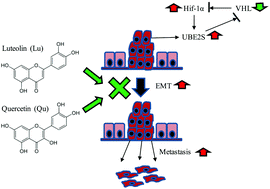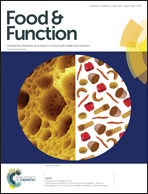Dietary flavonoids, luteolin and quercetin, inhibit invasion of cervical cancer by reduction of UBE2S through epithelial–mesenchymal transition signaling†
Abstract
We previously reported that the dietary flavonoids, luteolin and quercetin, might inhibit the invasiveness of cervical cancer by reversing epithelial–mesenchymal transition (EMT) signaling. However, the regulatory mechanism exerted by luteolin and quercetin is still unclear. This study analyzed the invasiveness activation by ubiquitin E2S ligase (UBE2S) through EMT signaling and inhibition by luteolin and quercetin. We found that UBE2S expression was significantly higher in highly invasive A431 subgroup III (A431-III) than A431-parental (A431-P) cells. UBE2S small interfering (si)RNA knockdown and overexpression experiments showed that UBE2S increased the migratory and invasive abilities of cancer cells through EMT signaling. Luteolin and quercetin significantly inhibited UBE2S expression. UBE2S showed a negative correlation with von Hippel-Lindau (VHL) and a positive correlation with hypoxia-induced factor (Hif)-1α. Our findings suggest that high UBE2S in malignant cancers contributes to cell motility through EMT signaling and is reversed by luteolin and quercetin. UBE2S might contribute to Hif-1α signaling in cervical cancer. These results show the metastatic inhibition of cervical cancer by luteolin and quercetin through reducing UBE2S expression, and provide a functional role for UBE2S in the motility of cervical cancer. UBE2S could be a potential therapeutic target in cervical cancer.



 Please wait while we load your content...
Please wait while we load your content...